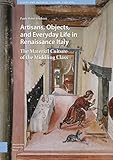Artisans, objects and everyday life in Renaissance Italy : the material culture of the middling class / Paula Hohti Erichsen.
Material type: TextSeries: Publication details: Amsterdam : Amsterdam University Press, (c)2020.Description: 1 online resource (364 pages) : illustrationsContent type:
TextSeries: Publication details: Amsterdam : Amsterdam University Press, (c)2020.Description: 1 online resource (364 pages) : illustrationsContent type: - text
- computer
- online resource
- 9789048550265
- 9048550262
- DG975 .A785 2020
- COPYRIGHT NOT covered - Click this link to request copyright permission: https://lib.ciu.edu/copyright-request-form
| Item type | Current library | Collection | Call number | URL | Status | Date due | Barcode | |
|---|---|---|---|---|---|---|---|---|
 Online Book (LOGIN USING YOUR MY CIU LOGIN AND PASSWORD)
Online Book (LOGIN USING YOUR MY CIU LOGIN AND PASSWORD)
|
G. Allen Fleece Library ONLINE | Non-fiction | DG975.5 (Browse shelf(Opens below)) | Link to resource | Available | on1223969117 |
Browsing G. Allen Fleece Library shelves, Shelving location: ONLINE, Collection: Non-fiction Close shelf browser (Hides shelf browser)
Includes bibliographies and index.
Introduction -- 1. Artisans and local traders in Renaissance Siena -- 2. The economic status of Sienese artisans and shopkeepers -- 3. Boundaries, borders, and hierarchies -- 4. Business and income -- 5. Buying and acquiring material goods -- 6. Dowries and the circulation of material goods -- 7. A respectable and comfortable home -- 8. Novelty, refinement, and "splendour" -- 9. The home on show -- Conclusion.
Did ordinary Italians have a 'Renaissance'? This book presents the first in-depth exploration of how artisans and small local traders experienced the material and cultural Renaissance. Drawing on a rich blend of sixteenth century visual and archival evidence, it examines how individuals and families at artisanal levels (such as shoemakers, barbers, bakers and innkeepers) lived and worked, managed their household economies and consumption, socialised in their homes, and engaged with the arts and the markets for luxury goods. It demonstrates that although the economic and social status of local craftsmen and traders was relatively low, their material possessions show how these men and women who rarely make it into the history books were fully engaged with contemporary culture, cultural customs and the urban way of life.--
COPYRIGHT NOT covered - Click this link to request copyright permission:
There are no comments on this title.







